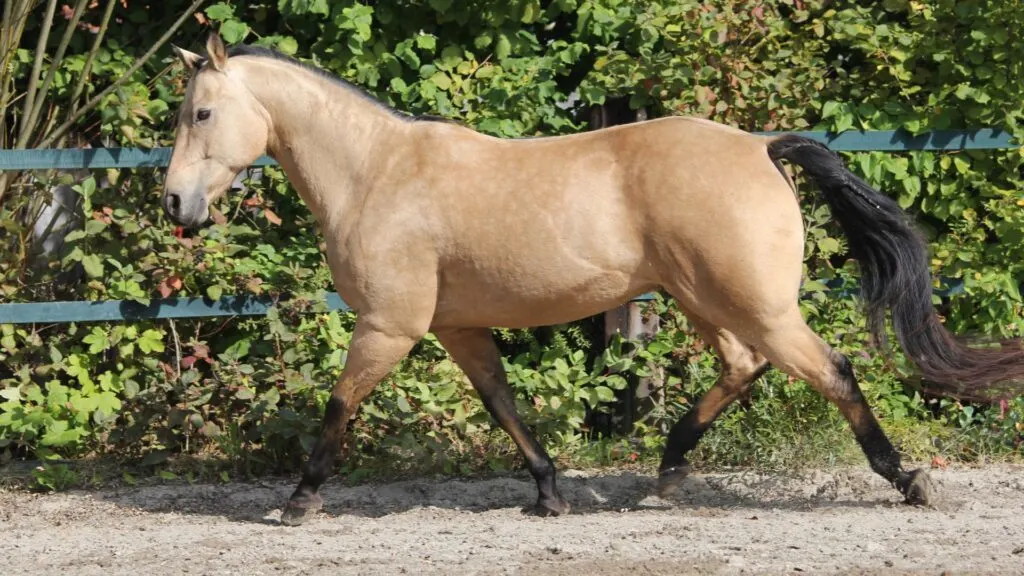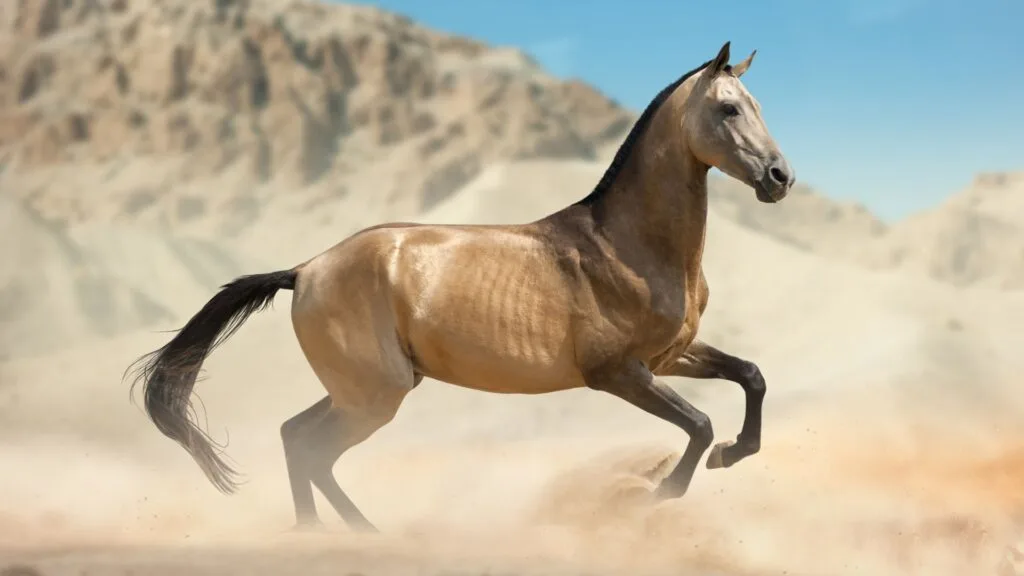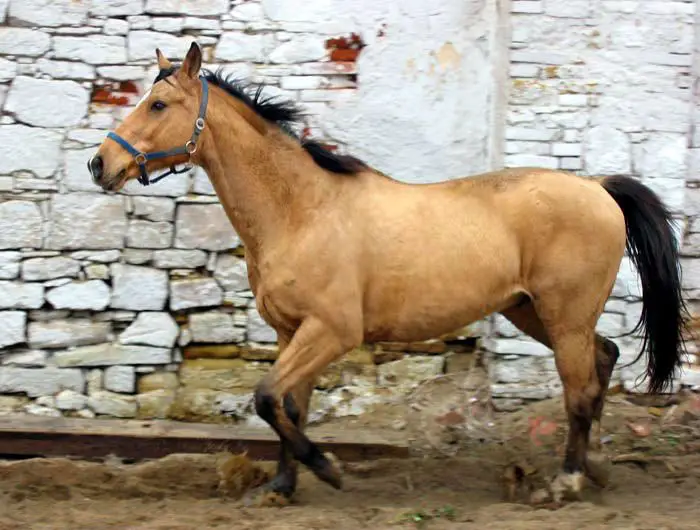Last updated: April 8, 2024
The buckskin horse, known for its unique tan coat and dark mane, is not a specific breed but a color type found in various horse breeds. This color is admired for more than its beauty; buckskin horses are also valued for their hardiness and strength.
As a passionate horse enthusiast and owner, my interest in Buckskin horses has taken me on an educational journey. Let’s dive into the fascinating world of Buckskin horses and explore their history, genetics, and how to care for them.
Buckskin Horse Colors

Although buckskin horses are renowned for their golden or tan coats with contrasting black points, they exhibit various color variations. Here’s a breakdown of these variations in a mobile-friendly format:
Standard Buckskin
- Color Description: The classic deer-like color.
- Key Characteristics: Standard Buckskins can vary from lighter to darker tones, which gives them the quintessential buckskin look.
Buttermilk Buckskin

- Color Description: This palest variation of buckskin features a light coat.
- Key Characteristics: Maintains dark points despite the lighter coat color.
Dusty Buckskin

- Color Description: Slightly lighter than the standard buckskin.
- Key Characteristics: Lacks a definitive dorsal stripe, giving a “dusty” appearance.
Sooty Buckskin

- Color Description: Features a darker overlay that resembles soot.
- Key Characteristics: Darker topcoat with a lighter undercoat, creating a striking contrast.
Silver Buckskin

- Color Description: Contains interwoven light gray hairs.
- Key Characteristics: Gives an almost gray appearance, distinguishing it from other variations.
Note on Distinguishing Features
- Eye Color: True buckskin horses typically have amber or brown eyes, contributing to their distinct look.
- Genetic Note: Horses resembling buckskins with blue eyes usually result from a double dilution gene, affecting both coat and eye color. They are not classified as true buckskins.
Buckskin Horse Breeds
Buckskin horses are not confined to a single breed; they can be found in various horse breeds. Here are some horse breeds known for their prevalence of buckskin coloration:
American Quarter Horse

- Color Frequency: Commonly found in buckskin.
- Unique Traits: They are known for their speed over short distances, versatility, and calm temperament. They excel in rodeo events, ranch work, and as family companions.
Morgan Horse
- Color Frequency: Buckskin occurs but is less common.
- Unique Traits: Compact and muscular, Morgans are friendly and cooperative, excelling in both English and Western disciplines, driving, and as family horses.
Andalusian Horse

- Color Frequency: Buckskin is rare but highly prized.
- Unique Traits: Noble and strong, with graceful movements, making them excellent in classical dressage, show jumping, and parade horses.
Tennessee Walking Horse
- Color Frequency: Buckskin is admired within the breed.
- Unique Traits: Known for their smooth gaits, especially the “running walk,” and their gentle nature, making them great trail and pleasure horses.
Connemara Pony
- Color Frequency: Relatively common in buckskin.
- Unique Traits: Athletic, versatile, and friendly, excelling in jumping, dressage, driving, and as children’s ponies.
Dutch Warmblood
- Color Frequency: Buckskin is rare.
- Unique Traits: Elegant, athletic, good-tempered, successful in dressage, show jumping, and eventing.
Arabian Horse

- Color Frequency: Buckskin is rare due to the breed’s strong genetic pool for other colors.
- Unique Traits: Arabians are known for their endurance, intelligence, and distinctive head shape. They excel in endurance riding, the show ring, and as versatile family horses.
Mustang
- Color Frequency: Buckskin appears in this wild and free-roaming breed.
- Unique Traits: Mustangs are hardy, have a strong survival instinct, and adapt well to various disciplines with proper training. They are symbols of the American West’s spirit.
Remember that buckskin horses can also appear in other breeds, demonstrating the widespread occurrence of this captivating coat color in the equine world.
Characteristics of Buckskin Horses

- Distinctive Coat Color: Known for their golden-tan coat and contrasting dark mane, tail, and lower legs, buckskin horses exhibit a unique coloration due to the cream dilution gene acting on a bay base coat.
- Genetic Trait, Not a Breed: Buckskin is a color trait found across various horse breeds, not a specific breed.
- Key Characteristics:
- Robust Health: Celebrated for their resilience and robust health.
- Strong Hooves: Often have strong hooves, enhancing their hardiness.
- Exceptional Stamina: Their stamina makes them versatile in various equestrian disciplines.
- Genetic Makeup:
- Cream Dilution Gene: Lightens the base coat to produce the signature golden tan.
- Distinct from Duns: Unlike duns, buckskins don’t have primitive markings like dorsal stripes due to the ‘dun gene.’
- Other Variations: These include palominos and dapples, which result from different genetic interactions.
Buckskin Horse History: Origin and Evolution

Buckskin horses emerged in Europe as symbols of elegance and resilience. The Spanish Sorraia, known for its hardiness, significantly influenced their lineage, especially as these horses interbred with native breeds like the Mustangs in North America.
- Early Roots: Emerged in Europe, symbolizing elegance and resilience.
- Spanish Sorraia Influence: Pivotal in shaping the breed, especially through cross-cultural breeding.
How Did Buckskin Horses Get Their Name?
“Buckskin” refers to the horse’s coat’s resemblance to tanned deerskin, or “buckskins.” Originally describing a type of leather, the term evolved to signify the distinctive golden-tan coat of these horses, linking material history with equine elegance.
In-Depth Video About Buckskin Horses
Delve deeper into the world of buckskin horses with this informative YouTube video by Seriously Equestrian.
Caring for Buckskin Horses
While buckskin horses captivate with their unique coloration, caring for them involves general horse care practices applicable to all breeds. Focusing on a balanced diet, regular grooming, routine health check-ups, and consistent exercise is crucial to ensure their health and well-being.
For those interested in learning more about comprehensive horse care, covering everything from dietary needs to grooming techniques and health maintenance, check out our detailed guide: Complete Horse Care Essentials. This resource provides in-depth information and tips to help you take the best care of your equine companion.

Famous Buckskin Horses in Hollywood and the Cowgirl Culture
Buckskin horses have left a significant mark on Hollywood and the cowgirl culture, celebrated for their beauty, versatility, and spirited nature. These horses have become iconic in American Western storytelling and modern horse sports.
Hollywood Spotlight:
- Buttermilk: Dale Evans’ mount in “The Roy Rogers Show,” showcasing the charm and reliability of buckskin horses.
- Spirit: The animated star of “Spirit: Stallion of the Cimarron” captivates audiences and enhances the appeal of buckskins.
- Buck: From “Gunsmoke,” symbolizing the deep bond between humans and horses.
Cowgirl Culture:
- Buckskins embody the rugged spirit of the American West, favored by legendary figures like Calamity Jane and Mabel Strickland.
- In modern Western horse sports, they continue to showcase their skills and beauty, from reining to barrel racing.
Cultural Legacy:
- Their presence in Western media and sports has bolstered their popularity and inspired a love for the adventurous cowboy and cowgirl culture.
- The legacy of buckskin horses in Hollywood and cowgirl culture highlights the enduring bond between humans and these magnificent animals.
Dun vs. Buckskin: Understanding the Differences


Dun and buckskin horses often get confused due to their similar coat colors, but specific genetic factors and unique markings distinguish them. Here’s a breakdown to clarify the differences:
Genetic Basis
- Dun: The dun gene dilutes the base coat color, adding distinctive “primitive” markings such as a dorsal stripe, leg barring, and sometimes shoulder stripes. The dun gene affects all base colors.
- Buckskin: Buckskin color results from the action of a single cream dilution gene on a bay base coat, lightening the coat to a golden color but leaving the mane, tail, and lower legs dark. It does not produce the primitive markings seen in duns.
Coat Color and Markings
- Dun Horses:
- Typically, they have a diluted coat color ranging from yellowish to reddish-brown, depending on the base color.
- Always have a dorsal stripe running down the spine, from the mane to the tail.
- It may have leg barring (zebra stripes on legs) and shoulder stripes.
- Buckskin Horses:
- Have a golden tan coat with a black mane, tail, and lower legs (black points).
- They do not have the dorsal stripe or other primitive markings characteristic of dun horses unless they also carry the dun gene.

Choosing a Buckskin Horse: Key Considerations
When selecting a buckskin horse, consider more than just its beautiful coat. Here’s a mobile-friendly guide to help you make an informed choice:
Temperament
- Compatibility: Match the horse’s temperament with your riding level and style. Options range from calm for beginners to spirited for the experienced.
- Behavior: Observe if the horse is cooperative, eager to learn, and comfortable with humans.
Health
- Veterinary Check: Get a pre-purchase exam to check for health issues, including eyes, teeth, and hooves.
- Soundness: The horse should show no lameness or discomfort.
Suitability for Intended Use
- Discipline: Identify if the horse suits your equestrian interests, such as western riding, dressage, or trail riding.
- Training Level: Ensure the horse’s training meets your skills and responds well to commands.
Responsible Breeding and Ownership
- Breeding Practices: Research the horse’s lineage and the breeder’s reputation for health and temperament focus.
- Commitment: Be ready for the responsibilities of horse ownership, including veterinary care and daily maintenance.
Additional Tips
- Pedigree and Registration: Check documents for breed purity or competition eligibility, if important.
- Ask Questions: Inquire about the horse’s history, health, and behavior. A reputable seller will be transparent.

Frequently Asked Questions (FAQs)
Are buckskin horses a specific breed?
No, buckskin refers to the coat color and not a specific breed. This color pattern can be found in various horse breeds.
What makes the coat of a buckskin horse unique?
The coat results from the cream dilution gene acting on a bay horse’s coat, giving it a distinctive golden-tan color with dark points (mane, tail, and lower legs).
How do I care for a buckskin horse’s coat to keep its color vibrant?
Regular grooming, protection from excessive sun exposure, and a balanced diet can help maintain the vibrant color of a buckskin horse’s coat.
Is it true that buckskin horses have stronger hooves?
Buckskin horses are often noted for having strong hooves, but this can vary depending on the horse’s breed.

Conclusion
Buckskin horses offer more than just their stunning golden appearance. Their history, from Spanish origins to the cream dilution gene, showcases beauty, resilience, and adaptability. We’ve covered essential care tips and their prowess in various equestrian disciplines, underscoring their broad versatility.
Exploring the world of buckskin horses reveals a deep connection between humans and these noble creatures, emphasizing the importance of knowledge, care, and respect for their heritage. Whether you’re an experienced rider, a new enthusiast, or simply an admirer, the journey with buckskin horses is rich with stories and learning opportunities.
Call-to-Action
As we conclude our exploration of the fascinating world of buckskin horses, I invite you to take your interest further and actively engage with the vibrant community that shares your passion.
Connect with the Community:
- Join equestrian forums, local horse clubs, or online communities to share experiences and connect with fellow horse enthusiasts. Participating in groups like the International Buckskin Horse Association (IBHA) or the American Buckskin Registry Association (ABRA) can offer you a platform to engage with others who are equally passionate about buckskin horses. These associations provide opportunities to participate in events, showcase your horses, and compete at various levels.
Continue Learning:
- The journey of equine knowledge is endless. Keep exploring through books, documentaries, and hands-on experiences. Associations like the National Buckskin Society (NBS) often host educational events and festivals where you can learn more about the heritage and care of buckskin horses. Every interaction, every event, adds a new chapter to your equine journey.
Share Your Stories:
- If you have experiences with buckskin horses, whether in competitive events like the All Breed Classic Horse Show or personal anecdotes from trail riding, share your stories. Your insights and experiences can enlighten others and contribute to the collective appreciation of these remarkable animals.
Engage in Events:
- Consider attending events like the Color Breed Congress, celebrating buckskin horses among other colorful breeds. These events are not just competitions; they are gatherings of enthusiasts and experts where you can gain new perspectives and deepen your understanding of these magnificent animals.
